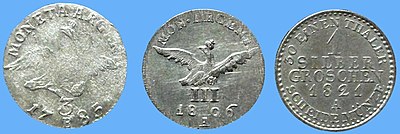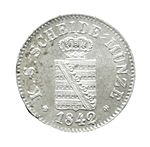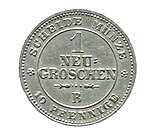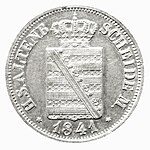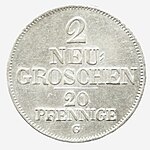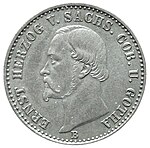Silver groschen
Silbergroschen is the name for three different German coin types from different eras: Saxon, Silesian and Prussian silver groschen.
Silver groschen in the Electorate of Saxony from 1475 to 1482
After several years of low penny coinage in the Duchy of Saxony, Elector Ernst and his brother Albrecht, both Margraves of Meissen and Wilhelm III. Landgrave of Thuringia introduced a new hard currency with the coinage order of December 28, 1474. The key point was the significant increase in the silver content of the coin mark from 5 to 8 lots to 15¼ lot = 953.125 ‰ fine.
The groschen coin struck from it, initially 140¼ pieces from the Erfurt Münzmark (235.4011 g) one piece = 1.68 g gross weight , divided into 9 pfennigs , was first referred to as silver groschen :
- "Silver in penny of the best silver in muntze" (Freiberg certificate from 1478)
- "Our main coin of silver groschen" (Coin Ordinance 1482)
- "Schneberger silberlein gröschlein" (coin sample in Würzburg 1496)
The minting began in 1475 in the reopened Zwickau mint under the mint master Conrad Funcke from the increasing silver production of the Schneeberger mines. Because the embossing showed a three-pass adorned with lace , the silver groschen was popularly known as the pointed groschen .
In other coin systems, the coin base was changed several times; see in detail under Pointed Groschen . The coinage order of January 13, 1482 increased the value of the pointed groschen to 12 pfennigs = 24 hellers . After the very high number of pieces of around 7.7 million pieces, another form of the pointed groschen was no longer planned.
The pointed groschen were very popular because of their high fine silver content and remained a means of payment until the 16th century. There were reprints of around 2.67 million pieces in the period from 1547 to 1553 under the Electors Moritz and August.
Silver groschen around 1800 in the Prussian provinces
After the end of the Seven Years' War led King Frederick II. In the Kingdom of Prussia and the Electoral Margraviate Brandenburg with that of Martin Kröncke developed Münzedikt of 29 March 1764 return to 14-dollars-monetary standard for Kurantmünzen and 18-dollars-monetary standard for fractional coins . In the process, the Polish and Silesian copper groschen circulating in the Prussian provinces were finally to be displaced by new coins containing silver.
For this purpose, from 1764 to 1765 and then from 1771 onwards, coins in the 21 guilder coin base were made of a silver alloy with the Arabic number 3 and from 1800 to 1808 with the Roman number III and the legend MONETA ARGENT (silver coin) worth one Prussian groschen issued for the provinces. The number of values results from the fact that Prussian 1 penny in Silesia the value of 3 Kreuzer and in Prussia of 3 Gröschel had.
The minting was done with 142½ pieces from the Mark at 233.8555 g with a fine silver content of 4 Lot 4 Grän = 263.89 ‰, thus 540 pieces from the fine Prussian Mark, fine weight = 0.433 g and rough weight = 1.641 g. Because these coins were not only made of copper, they were called silver groschen in contrast to the copper groschen.
In catalogs, these coins sometimes appear as three cruisers, but also correctly under the name of silver groschen.
After the royal edict of December 13, 1811, the melting of the divisional coins began. According to Section 3, the following course applied to Prussia and Silesia:
- 1 Prussian Reichstaler for 52½ silver groschen in bad coin
- 1 Prussian Reichstaler for 32 silver groschen in good coin
The Silesian silver groschen served as a template for the new silver groschen of the Prussian coin reform of 1821.
Silver groschen in the Kingdom of Prussia from 1821 to 1873
Requirements for a change
After the end of the Napoleonic Wars of Liberation, the coin system in the Kingdom of Prussia had to be completely reorganized as part of the upcoming reforms. Mainly the Minister of State Freiherr vom Stein advocated a uniform monetary standard in the decimal system for the entire kingdom, which he was only able to achieve in part.
On September 30, 1821, King Friedrich Wilhelm III signed. the new coin constitution. According to Articles 7 and 11 of the Coin Constitution, all regional coin systems were abolished and only the silver groschen (abbreviation Sgr) was introduced as a new divisional coin with a partial decimal system:
- Old classification: 1 thaler in the 14 thaler coin footer = 24 good groschen = 288 pfennigs
- New classification: 1 thaler in the 14 thaler coin footer = 30 silver groschen = 360 new pfennigs
Besides the Prussian EIN THALER , only the VI. A THALER minted as a Kurant coin. This 1/6 thaler was valid according to the subdivision = 5 silver groschen.
Although a thaler = 30 groschen = 300 pfennigs was already announced in section 13 of the royal edict of December 13, 1811, King Friedrich Wilhelm III. do not succeed in dividing the silver groschen into 10 pfennigs. The number 12 allows division into five simple numbers without a fraction, the number 10 only into three numbers without a fraction.
According to Articles 7 and 8 of the Coin Constitution, the silver groschen is to be minted in the 16 thaler coin base with 106⅔ pieces from the Prussian mark (233.8555 g) with 64 grän = 222.222 ‰ fine silver. In order for the currency to remain stable, these new dividing coins should only be minted where absolutely necessary.
In relation to the convention money, the silver groschen was significantly overvalued in the Kingdom of Prussia. The 1/12 thaler (double groschen) in the convention mint foot with 1.462 g fine silver received a rate of 2½ silver groschen with only 1.218 g fine silver from 1821.
This value ratio also applied to the old Prussian Kurant money:
| Silver groschen | Value in old Kurant | Old Kurant | new value | |
|---|---|---|---|---|
| ½ silver groschen = | 5 pfennigs | ½ groschen (6 old pennies) = | 8 new pennies | |
| 1 silver groschen = | 10 pfennigs | 1 penny = | 1 silver groschen 3 new pfennigs | |
| 2 silver groschen = | 1 groschen 7 pfennigs | 2 groschen = | 2 silver groschen 6 new pfennigs |
The large discount between Kuranttaler and Scheidemünze of 12.5% partially led to the fact that the silver groschen were initially disreputed as inferior coins abroad:
- 1 Taler Prussian Kurant = 16.704 g fine silver
- 30 silver groschen = 14.616 g fine silver
In Hesse, a warning was issued to the population that the silver groschen in 1821 was worth less than 3 kreuzers in 24 guilder feet instead of the actual value of 3½ kreuzers. Acceptance at public cash registers was prohibited.
The regulation in Section 7 of the Coin Act, according to which, in contrast to other countries, cutting coins could no longer be exchanged for Kurant coins, also contributed to the mistrust of the new coin. Even with payments to the state, in the Kingdom of Prussia there was an obligation to accept the silver groschen only for payments to be made below one sixth of a thaler (= 5 silver groschen).
It was only after the Vienna Mint Treaty of 1857 that an ordinance of 1858 in the Kingdom of Prussia permitted the exchange of divisional coins for curant coins if the value of the silver groschen exceeded 20 thalers.
The currency reform to introduce the silver groschen was successfully carried out according to the royal cabinet order of October 25, 1825.
Minting of the silver groschen in the Kingdom of Prussia from 1821 to 1856
Under King Friedrich Wilhelm III. (1797–1840) began to manufacture divisional coins in 1821 as whole and half silver groschen in ring minting. The mints of Berlin and Düsseldorf were involved in the development. The Berlin mint minted both denominations annually until 1840 and Düsseldorf the 1-silver penny piece 1821–1828, 1830, 1832–1834, 1837 and 1839–1840 and the ½-silver penny piece only 1824–1826 and 1828.
The coinage remained during the reign of King Friedrich Wilhelm III. unchanged. Slight deviations due to different stamps are possible:
- Obverse: head of the king in Biedermeier style with long sideburns to the right; Name and title of the mint owner as a legend, beginning at the bottom left in German capital letters: FRIEDR◦WILH◦III KOENIG V◦PREUSSEN
- Reverse: Nominal value in three lines: ½ or 1 / SILVER / GROSCHEN underneath the year and underneath the mint mark, in the upper part, with inward-facing letters, mandatory information about the partial ratio to the higher coin level: 60 or 30 EINEN THALER and in the lower part Part, with letters turned around the outside, information as SCHEIDE COIN. Only with the ½-silver groschenstück is the legend separated by two dots.
- Edge: Edge rods with an adjoining circle of separated pearls, edge smooth or at least partially finely grooved on the 1 silver groschen.
- Output:
| Nominal | Partial ratio to the higher coin level | Weight | Fineness | Piece afM | Fine weight |
| ½ silver groschen | 1/60 thaler | 1.096 g | 3 Loth 10 Grän = 222.22 ‰ | 960 | 0.244 g |
| 1 silver groschen | 1/30 thaler | 2.192 g | 3 Loth 10 Grän = 222.22 ‰ | 480 | 0.487 g |
The regulations of the Dresden Mint Treaty of the German Customs Union states and the special agreement of the states committed to the 14 thaler coin standard of July 30, 1838 did not contain any requirements that would have led to a change in the distribution of the silver groschen.
Under King Friedrich Wilhelm IV. (1840–1861) the production of the 1 silver groschen and ½ silver groschen pieces was continued from 1841 to 1852. Only the picture side of the pieces changed as follows:
- Youthful head of the king in Biedermeier style with long sideburns to the right; Name and title of the mint owner as a legend, beginning at the bottom left in German capital letters: FRIEDR.WILH.IV KOENIG V. PREUSSEN
The Berlin mint minted both denominations annually until 1852 and Düsseldorf only minted the 1 silver groschen from 1841–1845 and 1847–1848.
From June 1, 1843, a 2½ silver groschen was issued as an additional denomination. The collection of the old 1/12 thaler pieces with a value of 15 million thalers has progressed so far that the pieces still in circulation can no longer meet the demand for small coins. Even the previously pronounced whole and half silver groschen with a value of 3,325,000 thalers are not sufficient for small monetary transactions (incidentally, 1/6 thalers worth 33,336,000 thalers were minted in the same period). The mint took place in the Berlin mint from 1842–1844 and 1847–1852.
| Nominal | Partial ratio to the higher coin level | Weight | Fineness | Piece afM | Fine weight |
| 2 ½ silver groschen | 1/12 thaler | 3.248 g | 6 Loth = 375.00 ‰ +/- 1 Grän | 192 | 1.218 g |
In 1853 the obverse of the silver groschen received a new portrait of the king, adapted to the age of 58 years (that year was the 30th wedding anniversary of the king). In addition, the inscription of the 1 silver groschen and 2½ silver groschen has been changed:
- Older head portrait of the king in Biedermeier style with long sideburns to the right; Name and title of the mint owner as a legend, beginning at the bottom left in German capital letters: FRIEDR.WILHELM IV KOENIG V. PREUSSEN
All three denominations were minted annually from 1853 to 1856 only in the Berlin mint.
Minting of the silver groschen in the Kingdom of Prussia from 1857 to 1873
With the entry into force of the Vienna Mint Treaty on January 24, 1857, the further form of the silver groschen had to be adapted to the new coin weight of the inch pound. Thereafter, according to Sections 7 and 8 of the new Coin Act, a 34½-thaler coin standard applied to the cutting coins. The fineness was not changed. The changeover led to slight deviations in the fine weight. However, the previous coins remained equally valid.
The coinage of the silver groschen already complied with the provisions of Article 14 of the Vienna Mint Treaty of January 24, 1857. Thus, there were no external changes to the coins. The details of the embossing were regulated by a separate ordinance. The fineness of the whole and half silver groschen was reduced.
| Nominal | diameter | Weight old | Weight new | Fineness | Piece af pound | Fine weight old | Fine weight new |
| 2 ½ silver groschen | 21.0 mm | 3.248 g | 3.221 g | 375.00 ‰ | 414 | 1.218 g | 1.208 g |
| 1 silver groschen | 18.5 mm | 2.192 g | 2.196 g | 220.00 ‰ | 1,035 | 0.487 g | 0.483 g |
| ½ silver groschen | 15.0 mm | 1.096 g | 1.098 g | 220.00 ‰ | 2,070 | 0.244 g | 0.242 g |
With these changes, the Berlin Mint continued the minting of the entire silver groschen and 2½ silver groschen pieces with the portrait of King Friedrich Wilhelm IV every year from 1857 to 1860. The half silver groschen was minted only in 1858 and 1860. The assumption of regency by Prince Wilhelm from 1858 did not lead to any changes to the style.
The last period of minting of silver groschen followed under King Wilhelm I (1861–1888). The picture side shows the head of the king in Biedermeier style with mustache or whiskers to the right as well as the name and title of the mint owner as a legend in German capital letters: WILHELM KOENIG VON PRUSSEN. There were no changes on the value side. This coinage remained unchanged until the end of the coinage of the silver groschen.
The Berlin Mzz. A minted all three denominations annually from 1861 to 1873; the mint Hannover Mzz. B from 1869 to 1873 the 2½ silver groschen and annually from 1866 to 1873 the whole and half silver groschen and the Frankfurt a. M. Mzz. C annually from 1867 to 1873 the 1- and 2½-silver groschen piece and the half silver groschen in 1867, 1868 and 1872.
From 1857 to 1873 the Kingdom of Prussia produced silver groschen worth 4,063,945 thalers. That corresponded to only 2.62% of the country's coin production in the period mentioned.
Adoption and expression of the Prussian silver groschen in other countries
overview
The new trillion coin system was able to prevail in all countries that had decided in favor of the taler currency with the Dresden Coin Treaty of 1838. The Prussian small coin system was adopted either completely or only in part, with the fine weight of the groschen pieces always matching regardless of their coin name in the respective minting periods. Possible differences were:
- Different silver fineness with the same fine weight and thus different rough weight,
- different coin names and coins : silver groschen , new groschen or just groschen ,
- Subdivision of the groschen in the Prussian system in 12 pfennigs, in the Saxon system in 10 pfennigs and only in Hesse in 12 hellers and in Oldenburg in 12 swarms .
The following shows the production of the silver groschen after the Vienna Coin Treaty of January 24, 1857, as well as the designation of the silver groschen and their subdivision in the countries with thaler currency:
| country | Embossing period | Groschen production | Share of national | Coin name | Subdivision |
|---|---|---|---|---|---|
| the penny | Value in thalers | Coin production | |||
| Kingdom of Prussia | 1857-1873 | 4,063,944 | 2.62% | Silver groschen | 12 pfennings |
| Kingdom of Saxony | 1861-1873 | 433.292 | 1.23% | New penny | 10 pfennigs |
| Kingdom of Hanover | 1857-1866 | 410.941 | 8.30% | Penny | 10 pfennigs |
| Kingdom of Hanover | from 1866 | 0 | 0% | Silver groschen | 12 pfennings |
| Electorate of Hesse | 1857-1866 | 78,520 | 20.8% | Silver groschen | 12 lighter |
| Grand Duchy of Saxony-Weimar-Eisenach | 1858 | 15,000 | 8.48% | Silver groschen | 12 pfennings |
| Grand Duchy of Oldenburg | 1858-1869 | 142,625 | 49.95% | Penny | 12 flocks |
| Grand Duchy of Oldenburg for Birkenfeld | 1858 | 6,000 | 32.29% | Silver groschen | 12 pfennings |
| Duchy of Saxony-Altenburg | no | 0 | 0.00% | New penny | 10 pfennigs |
| Duchy of Saxe-Coburg-Gotha | 1858-1870 | 20,296 | 14.20% | Penny | 10 pfennigs |
| Duchy of Brunswick | 1857-1860 | 102,342 | 28.45% | Penny | 10 pfennigs |
| Duchies of Anhalt as a whole | 1859-1862 | 60,015 | 22.08% | Silver groschen | 12 pfennigs |
| Principality of Schwarzburg-Rudolstadt | no | 0 | 0.00% | Silver groschen | 12 pfennings |
| Principality of Schwarzburg-Sonderhausen | 1858-1870 | 12,000 | 22.47% | Silver groschen | 12 pfennigs |
| Principality of Waldeck and Pyrmont | 1867 | 6,000 | 13.57% | Silver groschen | 12 pfennigs |
| Principality of Reuss older line | 1868 | 3,000 | 11.28% | Silver groschen | 12 pfennigs |
| Principality of Reuss younger line | no | 0 | 0.00% | Silver groschen | 12 pfennigs |
| Principality of Schaumburg-Lippe | 1858 | 14,100 | 31.72% | Silver groschen | 12 pfennigs |
| Principality of Lippe | 1860 | 24,400 | 34.61% | Silver groschen | 12 pfennings |
Kingdom of Saxony
After the Kingdom of Saxony changed from the convention mint to the 14 thaler as the national currency in 1839, the production of small coins in the continuous decimal system began in 1841. Whole, half and double ten pfennig pieces were minted in the 16 thaler coin footer, later referred to only as 2, 1 and ½ new penny coins. The minting took place in Saxony with its own fineness at the same fine weight as the Prussian silver groschen:
| Nominal | Fine weight unchanged | Weight Saxony | Saxony fineness | Weight Prussia | Fineness Prussia |
| 2 new penny | 0.974 g | 3.118 g | 312.50 ‰ | - | - |
| 1 new penny | 0.487 g | 2.126 g | 229.17 ‰ | 2.192 g | 222.22 ‰ |
| ½ new penny | 0.244 g | 1.063 g | 229.17 ‰ | 1.096 g | 222.22 ‰ |
According to the Vienna Mint Agreement, there was initially no production of trillion coins because the pieces were still minted in very large numbers in 1856 and the Dresden mint was involved in the maximum production of club coins to combat the international banking crisis. From 1861 2 and 1 new penny pieces were minted again in the 34½ thaler coin footer in a significantly lower number of copies, again with their own fineness:
| Nominal | Fine weight unchanged | Weight Saxony | Saxony fineness | Weight Prussia | Fineness Prussia |
| 2 new penny | 0.967 g | 3.221 g | 300.00 ‰ | - | - |
| 1 new penny | 0.483 g | 2.100 g | 230.00 ‰ | 2.196 g | 220.00 ‰ |
During the period in which the Dresden Minting Convention was in force from 1840 to 1856, 1,816,900 thalers were minted in new groschen; a share of 5.77% of the country's total coin production during this period (excluding gold coins). From 1857 to 1873 the production of the new penny was only 433,292 thalers; a share of 1.23% of the country's total coin production during this period (excluding gold coins).
Kingdom of Hanover
The Kingdom of Hanover introduced the 14 thaler foot on July 1, 1834. The small coin system was not initially adopted. The thaler was further subdivided into 24 good groschen of 12 pfennigs each and 36 Mariengroschen of 8 pfennigs each. 1/12 and 1/24 taler pieces were also minted. It was not until 1858 that the Saxon small coin system was converted. The expression took place as a whole and half a groschen. After the annexation by Prussia in 1866, the division of groschen to the Prussian system was changed to 12 pfenningen each. Own coinage no longer took place.
Electorate of Hesse (-Kassel)
The electorate lay between the Prussian provinces, so that the 14 thaler foot was minted as early as 1819. The thaler was further subdivided into 24 groschen of 12 pfennigs or 16 hellers. In 1841 the conversion to silver groschen took place, but these were divided into 12 hellers. In addition, the expression took place with a different fineness with the same fine weight:
| Nominal | Minting time | Gross weight | Fineness | Fine weight |
| 2 silver groschen | only in 1842 | 2,600 g | 375.00 ‰ | 0.974 g |
| 1 silver groschen | from 1841 | 1.560 g | 312.50 ‰ | 0.487 g |
| ½ silver groschen | only in 1842 | 0.970 g | 250.00 ‰ | 0.244 g |
The 2½ silver groschen piece minted from 1852 corresponded to the Prussian coin. After the annexation by Prussia in 1866, the coins of the Electorate of Hesse were equated with the Prussian coins. Own coinage no longer took place.
Grand Duchy of Saxony-Weimar-Eisenach
With the coin constitution of October 27, 1840, the Grand Duchy took over the entire Prussian small coin system and had whole and half silver groschen minted in the Berlin mint in 1840 and 1858. During the period in which the Dresden Minting Convention was in force from 1840 to 1856, whole silver groschen to the value of 80,251 thalers and half silver groschen to the value of 39,995 thalers were produced. The share of both silver groschen in total coin production in the country, worth 520,490 thalers, was 23.10%.
Grand Duchy of Oldenburg and Principality of Birkenfeld
The Principality of Birkenfeld took over the 14 thaler coin base as early as 1838 and minted 2½ and 1 silver groschen pieces in 1848 and 1858 according to the Prussian small coin system and only in 1858 the ½ silver groschen piece with the groschen divided into 12 pfennigs. The 2½ groschen piece minted in 1858 and the whole and half groschen pieces for Oldenburg minted from 1858 to 1869 corresponded to the Prussian silver groschen. However, the penny was divided into 12 swarms. Groschen and silver groschen were equivalent.
Duchies of Anhalt
In 1850 the Duchy took over the Prussian coinage system and had 2½ and 1 silver groschen pieces minted from 1851 to 1864 in the Berlin mint according to its technical data and design. The silver groschen was divided into 12 pfennigs.
Duchy of Saxony-Altenburg
With the Coin Act of 1840, the country changed from the convention coin foot to the 14 thaler foot and adopted the Saxon small coin system unchanged. The double, single and half new groschen were struck only from 1841 to 1842 in the Dresden mint to the value of 26,200 thalers. That is 18.09% of the total coin production in the country, worth 144,859 thalers, during the period in which the Dresden Coin Convention was in force from 1840 to 1856.
In Altenburg, at the same time as the first issue of the Neugroschen, extensive forgeries of the 2-Neugroschen piece became known. The two-penny piece made of copper, which was colored white with mercury, was used. The forgery could be recognized by the fact that the year between the two stars was missing under the coat of arms. This was on the value side of the two-penny piece.
Duchy of Saxe-Coburg-Gotha
With the accession to the Dresden Mint Treaty in 1838, the Saxon small coin system with the subdivision of the thaler into 30 groschen of 10 pfennigs each was adopted in the areas of Coburg and Gotha. The double, single and half groschen pieces minted in the Dresden Mint from 1841 and from 1858 retained the name Groschen, with which the last 1/24 thaler in the convention mint was named.
Duchy of Brunswick
The Duchy of Braunschweig, bordering on Prussia, changed from the Leipzig 12 thaler foot to the Prussian 14 thaler foot with the law of December 18, 1834. However, the thaler continued to be divided into 24 good groschen of 12 pfennigs each and 36 Mariengroschen of 8 pfennigs each. From January 1, 1858, the Saxon small coin system with the coin name Groschen was in effect. Whole and half penny pieces were only issued from 1857 to 1860.
Principality of Reuss older and younger line
The principalities switched from the convention to the 14 thaler and adopted the Prussian small coin system with the subdivision of the silver penny into 12 pfennigs. The simple silver groschen was minted at the Berlin mint from 1841 to 1855 with interruption. In 1841 the older line coined a ½ silver groschen. A 2-silver groschen piece was struck in 1850 by the younger line with the fineness of the Saxon 2-groschen piece of 312.5 ‰ silver. Hesse minted this piece in 1842 with 375.00 ‰ silver.
Principality of Schwarzburg-Sondershausen
After 75 years without minting, the principality began again to issue its own coins according to the Dresden Coin Convention. From 1846 to 1870 the whole and half silver groschen were minted in the Berlin mint according to the Prussian system with the subdivision of the silver groschen into 12 pfennigs.
Principality of Schwarzburg-Rudolstadt
In 1841 the principality minted the whole and half silver groschen in the Berlin mint according to the Prussian small coin system including the subdivision of the silver groschen into 12 pfennings.
Principality of Schaumburg-Lippe
In the principality the convention mint was used. The thaler was divided into 24 good groschen of 12 pfennigs each and 36 Mariengroschen of 8 pfennigs each. There was no accession to the Dresden Coin Convention. The principality renounced the exercise of the right to coin. After joining the Vienna Mint Treaty, the principality minted 2½, 1 and ½ silver groschen pieces only in 1858 according to the Prussian small coin system with the subdivision of the silver groschen into 12 pfennigs.
Principality of Lippe
The Principality of Lippe adopted the 14 thaler coin base and the Prussian small coin system including the division of the silver groschen into 12 pfennings. In 1847 and 1860 the 2½ and 1 silver groschen and only in 1847 the ½ silver groschen were minted in the Berlin mint.
Principality of Waldeck and Pyrmont
After the minting in the convention foot, the thaler at 36 Mariengroschen, the Prussian small coin system was adopted in 1836 and the silver groschen piece was minted at 12 pfennigs from 1836–1855. Another issue took place under Prussian administration in 1867 in the Hanover mint.
Suspension of the silver groschen
After the introduction of the Reich currency, the nominal values remain in accordance with Article 15 No. 3 of the Coin Act
- 2½ silver groschen worth 25 pfennigs
- 2 silver groschen worth 20 pfennigs
- 1 silver groschen worth 10 pfennigs
- ½ silver groschen worth 5 pfennigs
Means of payment in place of the imperial coins until the cancellation from June 1, 1876 at the same value. The exchange had to be made by August 31, 1876 at the cash registers of the states that minted these coins or in whose territory the same means of payment are used.
The coin denomination Groschen was banned with the introduction of the Reich currency. They had to be officially called penny pieces.
Individual evidence
- ^ Schrötter, Friedrich von: Dictionary der Münzkunde, 2nd edition 1970, p. 636
- ^ Friedrich Freiherr von Schrötter : Dictionary der Münzkunde, 2nd edition 1970, pp. 636, 650
- ^ Krug, Gerhard: Die Meissnisch-Sächsischen Groschen 1338–1500, Berlin 1974, p. 94, notes 462 and 97, notes 477 and 478
- ^ Krug, Gerhard: The Meissnisch-Sächsischen Groschen 1338-1500 , Berlin 1974, pp. 94ff, 177ff.
- ^ Stößel, Johann Christoph: An attempt at a Chur-Saxon coin history , Chemnitz 1780, p. 167.
- ↑ Keilitz, Claus / Kahnt, Helmut: The Saxon-Albertine coins 1547-1611 , 2nd edition 2014, p 38ff. and 102ff.
- ^ Rittmann, Herbert: Deutsche Geldgeschichte 1484–1914 , Battenberg 1975, p. 521.
- ↑ Schön, Gerhard: German coin catalog 18th century 1700–1806 , 4th edition 2008, p. 810 No. 61 and 62 and p. 993f. No. 71, 73 and 79.
- ↑ Arnold / Küthmann / Steinhilber: Large German coin catalog from 1800 to today , 29th edition 2014, p. 298 No. 36
- ↑ Edict on the melting and re-minting of the coin in Courant. From 13. December 1811; Law Collection for the Royal Prussian States 1811, No. 66, p. 373ff.
- ^ Schrötter, Friedrich von: Dictionary der Münzkunde, 2nd edition 1970, p. 636
- ↑ Law on Münzverfassung in the Prussian States by 30 September 1821; Law Collection for the Royal Prussian States 1821, No. 673, p. 159ff.
- ^ Rittmann, Herbert: Deutsche Geldgeschichte 1484–1914, Battenberg 1975, p. 520
- ↑ notice the 27th November 1821, for and with the Vergleichungs table of Werth's more foreign money places against Prussian money. Law Collection for the Royal Prussian States 1821, No. 685, pp. 190ff.
- ↑ Value comparison tables of the new silver groschen and copper coins against the Silesian, Prussian and Posener coins that are still in circulation, including Brandenburgian Scheidemünze. November 15, 1821; Law Collection for the Royal Prussian States 1822, No. 694, p. 2ff.
- ^ Rittmann, Herbert: Deutsche Geldgeschichte 1484–1914, Battenberg 1975, p. 524
- ↑ Klüber, Johann Ludwig: The coinage in Germany after its current state ...; 1828, pp. 28 and 32
- ↑ Law on Münzverfassung in the Prussian States by 30 September 1821; Law Collection for the Royal Prussian States 1821, No. 673, p. 160
- ↑ Ordinance regarding the exchange of domestic coins against Kurant at the state treasuries. From February 15, 1858. Collection of laws for the Royal Prussian States 1858, no. 4839, p. 42
- ^ Highest Cabinet Order of October 25th, 1825. That in future contracts and invoices the designation of groschen should only be understood to mean silver groschen; Law Collection for the Royal Prussian States 1825, No. 974, p. 227
- ^ Arnold / Küthmann / Steinhilber, revised and expanded by Faßbender, Dieter Großer Deutscher Münzkatalog von 1800 bis today, 29th edition 2014, p. 295f. No. 27 and 30
- ↑ General Coin Convention of the States Associated with Customs and Trade Associations. July 30, 1838; Collection of laws for the Royal Prussian States 1839, No. 1960, pp. 18ff.
- ^ Arnold / Küthmann / Steinhilber, revised and expanded by Faßbender, Dieter Großer Deutscher Münzkatalog from 1800 to today, 29th edition 2014, p. 307 No. 83, 85 and 87
- ↑ Ordinance regarding the issue of two and a half silver groschen coins. June 28, 1843; Collection of Laws for the Royal Prussian States 1843, No. 2357, p. 265f.
- ^ Arnold / Küthmann / Steinhilber, reworked and expanded by Faßbender, Dieter Großer Deutscher Münzkatalog from 1800 to today, 29th edition 2014, p. 307 No. 84, 86 and 88
- ^ Law on coinage. May 4, 1857; Law collection for the Royal Prussian States, 1857 No. 4666, p. 305ff.
- ^ Ordinance on the form and minting of the types of coin, which are minted in accordance with the law of May 4, 1857. On coinage. From June 21, 1858. Collection of laws for the Royal Prussian States, 1858 No. 4920, p. 365ff.
- ↑ Law, the future Münzverfassung in the kingdom of Saxony concerning; from July 20, 1840, Law and Ordinance Gazette for the Kingdom of Saxony 1840, 13th issue No. 61. p. 173ff.
- ↑ Lorenz, Rudolf: The coins of the Kingdom of Saxony 1806-1871, Berlin 1968, p. 69ff.
- ↑ Lorenz, Rudolf: The coins of the Kingdom of Saxony 1806-1871, Berlin 1968, p. 92ff.
- ^ Zich, Wilhelm: The Vienna Coin Contract of January 24, 1857 and Carl Ludwig von Bruck, dissertation at the University of Vienna, August 2009, pp. 141ff.
- ^ Arnold / Küthmann / Steinhilber, revised and expanded by Faßbender, Dieter Großer Deutscher Münzkatalog from 1800 to today, 29th edition 2014, p. 186ff.
- ^ Arnold / Küthmann / Steinhilber, revised and expanded by Faßbender, Dieter Großer Deutscher Münzkatalog from 1800 to today, 29th edition 2014, p. 385ff.
- ^ Arnold / Küthmann / Steinhilber, revised and expanded by Faßbender, Dieter Großer Deutscher Münzkatalog from 1800 to today, 29th edition 2014, p. 186ff.
- ^ Arnold / Küthmann / Steinhilber, revised and expanded by Faßbender, Dieter Großer Deutscher Münzkatalog from 1800 to today, 29th edition 2014, p. 17ff.
- ↑ Law on coinage in the Herzogthume Sachsen-Altenburg of November 28, 1840; Herzogl. Saxony-Altenburg. Collection of Laws, 1840, Item VII., No. 44, pp. 103f.
- ^ Announcement of the state government concerning the falsification and fraudulent issue of the Ducal Saxony-Altenburg two-penny pieces, dated February 22, 1841; Herzogl. Saxony-Altenburg. Collection of Laws, 1841, Part III., No. 23, p. 54
- ^ Arnold / Küthmann / Steinhilber, revised and expanded by Faßbender, Dieter Großer Deutscher Münzkatalog from 1800 to today, 29th edition 2014, p. 400ff.
- ^ Zich, Wilhelm: The Vienna Coin Contract of January 24, 1857 and Carl Ludwig von Bruck, dissertation at the University of Vienna, August 2009, p. 156ff.
- ^ Arnold / Küthmann / Steinhilber, revised and expanded by Faßbender, Dieter Großer Deutscher Münzkatalog from 1800 to today, 29th edition 2014, p. 322ff.
- ^ Arnold / Küthmann / Steinhilber, revised and expanded by Faßbender, Dieter Großer Deutscher Münzkatalog from 1800 to today, 29th edition 2014, p. 455ff.
- ^ Arnold / Küthmann / Steinhilber, revised and expanded by Faßbender, Dieter Großer Deutscher Münzkatalog from 1800 to today, 29th edition 2014, p. 448ff.
- ^ Arnold / Küthmann / Steinhilber, revised and expanded by Faßbender, Dieter Großer Deutscher Münzkatalog from 1800 to today, 29th edition 2014, p. 436ff.
- ^ Arnold / Küthmann / Steinhilber, revised and expanded by Faßbender, Dieter Großer Deutscher Münzkatalog from 1800 to today, 29th edition 2014, p. 235ff.
- ^ Zich, Wilhelm: The Vienna Coin Contract of January 24, 1857 and Carl Ludwig von Bruck, dissertation at the University of Vienna, August 2009, p. 170ff.
- ↑ Coin Act. From July 9, 1873, Deutsches Reichsgesetzblatt Volume 1873, No. 22 pp. 233-240 and announcement, regarding the suspension of currency coins from Thalerwurrency. From April 12, 1876, Deutsches Reichsgesetzblatt Volume 1876, No. 11 p. 162



